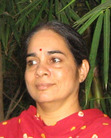Harini Gopalswami Srinivasan's Blog: Read, Write and Left, page 3
February 29, 2012
The Muse and the Mouse
Once upon a time, there was a Muse. Sometimes, once in a very long while, she would sidle into your mind, fill your thoughts, and gently but inexorably push you to pen and paper. Never mind that you never could adequately translate those thoughts to words.
Enter the Mouse. That cute, seductive, sneaky, destructive little rodent. Or, as Burns so much better put it, the "wee, sleekit, cowrin timrous beastie". And your writerly life is taken over by rodental habits -- continually nibbling at titbits, making little sorties here and there to uncover crumbs, twitching your nose at something, feeling something else with quivering whiskers, darting off at an elusive smell, starting in terror at an unusual sound, singing in a squeaky treble...
Exit the Muse in a huff.
Enter the Mouse. That cute, seductive, sneaky, destructive little rodent. Or, as Burns so much better put it, the "wee, sleekit, cowrin timrous beastie". And your writerly life is taken over by rodental habits -- continually nibbling at titbits, making little sorties here and there to uncover crumbs, twitching your nose at something, feeling something else with quivering whiskers, darting off at an elusive smell, starting in terror at an unusual sound, singing in a squeaky treble...
Exit the Muse in a huff.
Published on February 29, 2012 09:52
January 9, 2012
Elephants and other people
Just got back after a refreshing break at Swarga. No, not a near-death experience, but a home stay near Sakleshpur that really lives up to its name. They have 7 assorted dogs and a retired racehorse that have the run of the estate! It was really my idea of heaven, not forgetting the lovely coconutty meals. Topshe was horrified and fascinated by these free-living and free-thinking animals; and was driven into a frenzy by the huge hulk of a horse which ambled around us curiously the evening of our arrival. I wish I could spend a couple of months there with Topshe -- it would surely cure all our city-bred neuroses.
Getting back, we saw this horrific news item about an over-enthusiastic amateur photographer getting killed by an alephant near Bannerghatta. Coming not long after the elephant incident in Mysore city, the trend indicated by these events is very disturbing. Are we headed for an intense man-elephant conflict in the future? Of course there can be no doubt of the outcome if such a conflict ever has to be fought to a finish.
Nearer home, the elephants have also been raiding the avarai (bean) crop on our farm. Unlike the villagers, we are not dependent on farming for our livelihood. So we are only too happy to have them eat whatever we grow, though I do rather grudge them the coconut sapling they ate -- I planted it by the sweat of my brow. However, I don't think avarai is their favourite food. The villagers say the elephants are fond of ragi -- the staple food in this region -- and habitually make nocturnal raids before the harvest in December-January. The villagers keep all-nght vigils in this period, staying in terrifyingly flimsy tents and machans, and bursting crackers to scare away the animals. They generally manage to save enough of the crop to live on and when they don't the government compensates them.
We are considering growing stuff that elephants like along our boundary -- bananas, sugar cane and jackfruit -- rather than the recommended chilli fence to keep them out. Hopefully they will eat and go their sated way, but there's an equal chance they'll barge right in looking for more. Time will tell.
Anyway, the horizon seems full of elephants, and this brings me to the interesting story related by Chirag, our host at Swarga. Apparently the Sakleshpur area was once hardly frequented by elephants. Then about seven years ago, the bamboo flowered and died, and their staple food disappeared. That's when they started raiding the fields and farms of the region. When the herd was still a manageable size, the government marked out a portion of land to be restored to the forest, and asked the estate owners to sell them so many acres each at a very good price -- which they were very glad to do, as estates were then in a slump. Chirag's family has 850 acres (bought by his great-great-great grandfather in 1939 for the princely sum of Rs. 10,000), and I guess they wouldn't notice if they lost a hundred or so of that. The government also planned to evacuate a certain number of villages in the area, relocate the villagers and provide them employment. However, these good intentions were never carried through, the elephant herd has grown to about 70 and the number of villages that would need to be evacuated is a near impossible 120. It's doubtful that it can be carried out now. And the problem has now assumed elephantine proportions.
It's a lesson on the ill effects of procrastination. And a poser on how to preserve wildlife and simultaneously ensure human safety as the forests dwindle. Is it possible to grow enough food for both ourselves and the animals that we have dispossessed? And if we stay out of their way, will they stay out of ours? I firmly believe that the best thing you can do for wildlife is to leave it alone. We cannot restore our farmland to the forest -- there is too much intervening human habitation anyway, and the area has long been under cultivation. But we propose not to put up fences, and to let the animals wander in and, importantly, out. And when they are around, stay quietly indoors. Anyway, it is unusual for wild animals to frequent habited places by day. We hope to look more closely into this question of sharing habitat when we have built our little house and moved in, in a couple of years' time.
Getting back, we saw this horrific news item about an over-enthusiastic amateur photographer getting killed by an alephant near Bannerghatta. Coming not long after the elephant incident in Mysore city, the trend indicated by these events is very disturbing. Are we headed for an intense man-elephant conflict in the future? Of course there can be no doubt of the outcome if such a conflict ever has to be fought to a finish.
Nearer home, the elephants have also been raiding the avarai (bean) crop on our farm. Unlike the villagers, we are not dependent on farming for our livelihood. So we are only too happy to have them eat whatever we grow, though I do rather grudge them the coconut sapling they ate -- I planted it by the sweat of my brow. However, I don't think avarai is their favourite food. The villagers say the elephants are fond of ragi -- the staple food in this region -- and habitually make nocturnal raids before the harvest in December-January. The villagers keep all-nght vigils in this period, staying in terrifyingly flimsy tents and machans, and bursting crackers to scare away the animals. They generally manage to save enough of the crop to live on and when they don't the government compensates them.
We are considering growing stuff that elephants like along our boundary -- bananas, sugar cane and jackfruit -- rather than the recommended chilli fence to keep them out. Hopefully they will eat and go their sated way, but there's an equal chance they'll barge right in looking for more. Time will tell.
Anyway, the horizon seems full of elephants, and this brings me to the interesting story related by Chirag, our host at Swarga. Apparently the Sakleshpur area was once hardly frequented by elephants. Then about seven years ago, the bamboo flowered and died, and their staple food disappeared. That's when they started raiding the fields and farms of the region. When the herd was still a manageable size, the government marked out a portion of land to be restored to the forest, and asked the estate owners to sell them so many acres each at a very good price -- which they were very glad to do, as estates were then in a slump. Chirag's family has 850 acres (bought by his great-great-great grandfather in 1939 for the princely sum of Rs. 10,000), and I guess they wouldn't notice if they lost a hundred or so of that. The government also planned to evacuate a certain number of villages in the area, relocate the villagers and provide them employment. However, these good intentions were never carried through, the elephant herd has grown to about 70 and the number of villages that would need to be evacuated is a near impossible 120. It's doubtful that it can be carried out now. And the problem has now assumed elephantine proportions.
It's a lesson on the ill effects of procrastination. And a poser on how to preserve wildlife and simultaneously ensure human safety as the forests dwindle. Is it possible to grow enough food for both ourselves and the animals that we have dispossessed? And if we stay out of their way, will they stay out of ours? I firmly believe that the best thing you can do for wildlife is to leave it alone. We cannot restore our farmland to the forest -- there is too much intervening human habitation anyway, and the area has long been under cultivation. But we propose not to put up fences, and to let the animals wander in and, importantly, out. And when they are around, stay quietly indoors. Anyway, it is unusual for wild animals to frequent habited places by day. We hope to look more closely into this question of sharing habitat when we have built our little house and moved in, in a couple of years' time.
Published on January 09, 2012 08:40
December 8, 2011
Catwalk
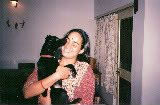 I was about ten when this photographer came to my friend Vidya’s house. He was her father's friend. He brought a bunch of animals with him -- an adorable brown puppy, a floppy-eared rabbit and a fluffy yellow chicken. I was mad about animals; was a bit of an animal myself. I didn't know or care much about human beings. Anyway, I went and slobbered all over the animals, completely ignoring the people. Man, I must have been an obnoxious kid.
I was about ten when this photographer came to my friend Vidya’s house. He was her father's friend. He brought a bunch of animals with him -- an adorable brown puppy, a floppy-eared rabbit and a fluffy yellow chicken. I was mad about animals; was a bit of an animal myself. I didn't know or care much about human beings. Anyway, I went and slobbered all over the animals, completely ignoring the people. Man, I must have been an obnoxious kid.Quite a while later, it dawned on me that these animals hadn’t been brought over just to delight me. The photographer was here on assignment. He had to create a calendar of children playing with animals. When I heard this, I was so excited. I was the only kid around who was comfortable handling the animals. My friends all stood at a distance, fascinated-but-horrified, squealed if fur touched them, and objected strongly to being licked or nibbled at – everything my soul craved. I had had no ambitions before, but now I wanted to be the calendar girl. Suddenly, it seemed like I was going to be catapulted to stardom, and I was drunk on the prospect.
One of my friends, Mini, was particularly squeamish about animals. But she was fair, soft, sweet and pretty, while I was brown, bony, awkward and wild. She was chosen to be photographed cuddling the animals. Her parents were called over to encourage and coax her into the poses that the photographer had set his heart on. I finally tumbled to a realization of how much looks count. It was devastating, and the sense of rejection stayed with me for years. Am I free of it now? I think so. At least I know that the photographer was an ass.
Published on December 08, 2011 22:55
November 17, 2011
Land ho!
Earlier this week, our coconut seedlings arrived. No one else was free, so I went by myself to plant them. And had the place all to myself for the first time. Oh, the bliss!

What is it about land that perceptibly expands your soul? Our bit of land is not vast, and it isn’t spectacular. But there isn’t a scrap of wall or fence visible to the naked eye. You can stand on the hilltop and pretend, if you like, that you own a hundred acres instead of four. You can look out over the undulating terrain with its little lake (that elephants are supposed to frequent, giving the village its name – Anaikere), breathe deep, and live in the moment. You can sit inside one of the dolmens (I frequently do) and make believe you’re a cave woman brandishing a burning stick of firewood at the sabre-toothed tiger that’s looking in at you. Time rolls away. The land doesn’t measure time, it doesn’t measure space. It doesn’t care about ownership or happiness or sorrow. It just is. And you simply dissolve into it.
If one could only hold onto this feeling for long enough, I feel sure, one would know Brahman. But being a restless soul, I soon begin to make plans. We have a well to be dug and a house to be built. (I loved the water diviner, who lets a leaf or a twig tell him where the water is.) I have long lists of trees to plant for fruit, flowers and leaves, for attracting birds and bees. I want a large, limpid pond for wildlife and lotuses. I want, I want… But one day I will stop wanting and be content just feeling the land.

What is it about land that perceptibly expands your soul? Our bit of land is not vast, and it isn’t spectacular. But there isn’t a scrap of wall or fence visible to the naked eye. You can stand on the hilltop and pretend, if you like, that you own a hundred acres instead of four. You can look out over the undulating terrain with its little lake (that elephants are supposed to frequent, giving the village its name – Anaikere), breathe deep, and live in the moment. You can sit inside one of the dolmens (I frequently do) and make believe you’re a cave woman brandishing a burning stick of firewood at the sabre-toothed tiger that’s looking in at you. Time rolls away. The land doesn’t measure time, it doesn’t measure space. It doesn’t care about ownership or happiness or sorrow. It just is. And you simply dissolve into it.
If one could only hold onto this feeling for long enough, I feel sure, one would know Brahman. But being a restless soul, I soon begin to make plans. We have a well to be dug and a house to be built. (I loved the water diviner, who lets a leaf or a twig tell him where the water is.) I have long lists of trees to plant for fruit, flowers and leaves, for attracting birds and bees. I want a large, limpid pond for wildlife and lotuses. I want, I want… But one day I will stop wanting and be content just feeling the land.
Published on November 17, 2011 22:38
November 2, 2011
Upward, downward, bell or cup?
Recently I was looking at the shortlist of an international book prize, and thinking sadly, “I bet they’ll all be miserable.” That got me wondering, not for the first time, why misery is considered more literary than happiness. There have been a lot of great books in the past with happy endings, so why is no one writing them any more? At best, you may have the protagonist coming through a crisis with his/her spirit unbroken; but joy? Unheard of, absurd! Is joy old fashioned, or is it unrealistic? I guess expecting it to continue ever after is unrealistic, but that should not prevent an author from ending a book on an optimistic note.
Anyway, thinking of all the books I’ve read, happy and otherwise, I realized that there are four common shapes to their stories – the upward slope, the downward slope, the bell shape and the cup shape. The upward slope begins with a miserable childhood, like many of the Dickenses, and goes gradually upward to a happy place in the protagonist’s life. The downward slope is just the opposite. Think of Macbeth or The Great Gatsby. The bell generally follows a person’s life and may be spread out across several books, like the fortunes of Soames in the Forsyte Saga. And the cup is the commonest shape in children’s books – begins happily, plumbs the depths of a crisis in the protagonist’s life, and climbs out of the abyss to a happy ending.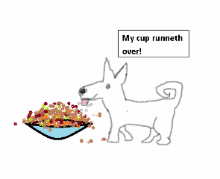
The Hobbit is something like this, but it is also a picaresque, or episodic, novel, with many minor highs and lows.
Now that I think about it, there must be other shapes. The classic detective novel doesn’t really seem to fall into any of these categories. I’d be very interested to hear if anyone has any ideas on this classification.
Anyway, thinking of all the books I’ve read, happy and otherwise, I realized that there are four common shapes to their stories – the upward slope, the downward slope, the bell shape and the cup shape. The upward slope begins with a miserable childhood, like many of the Dickenses, and goes gradually upward to a happy place in the protagonist’s life. The downward slope is just the opposite. Think of Macbeth or The Great Gatsby. The bell generally follows a person’s life and may be spread out across several books, like the fortunes of Soames in the Forsyte Saga. And the cup is the commonest shape in children’s books – begins happily, plumbs the depths of a crisis in the protagonist’s life, and climbs out of the abyss to a happy ending.

The Hobbit is something like this, but it is also a picaresque, or episodic, novel, with many minor highs and lows.
Now that I think about it, there must be other shapes. The classic detective novel doesn’t really seem to fall into any of these categories. I’d be very interested to hear if anyone has any ideas on this classification.
Published on November 02, 2011 23:12
October 11, 2011
Chasing Sarabhas
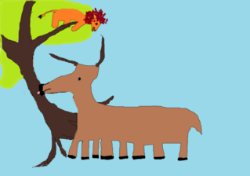
One of the most enticing -- and often wasteful -- things about writing is the chasing after rainbows, strange creatures, unknown facts (which everyone else apparently knew all along, but not the less thrilling for that) and so on. I'm sure it was always this way, but today Google and Wikipedia have a lot to answer for. Anyway, here are some thrilling finds I've made so far about the Ramayana:
1. Kaikeyi's native home Kekeya was in present day Afghanistan. Would it be politically incorrect to say it explains a lot?!
2. Kekeya's neighbour to its east was the kingdom of Bahlika, modern Balkh. Zoroaster preached his first sermons (or whatever they called them) there, and made his first converts. So the Parsis of India were near neighbours of Kaikeyi too.
See map of Epic India showing these places here: http://en.wikipedia.org/wiki/File:Epi...
3. When Lava and Kusha first recited the Ramayana to a select audience of rishis, they were showered with gifts, including -- a water pot, the bark of a tree to be used as a loin cloth, the skin of a black deer (used for sitting on when doing tapas), a sacred thread, a girdle of Munba grass, a hatchet a piece of red cloth, a string for binding one’s matted hair, a cord for tying up bundles of wood, some firewood and a piece of Udumbara wood for sitting on. I LOVE these gifts! How easy life would be if we could give people such useful things.
4. There was an eight-legged deer called the Sarabha, which was stronger than a lion.
Published on October 11, 2011 09:33
September 12, 2011
A Baby Elephant Comes to Visit!!!
A few days ago, we went on a picnic to our farmland. It had rained in the night and there were puddles everywhere. And there, next to one of the puddles, was the adorable round footprint of a baby elephant! It was about 7 inches in diameter. Near it was a not so adorable pile of elephant poo. By the way, did you know they make paper out of it? Yes, really, and it's strangely non-disgusting. A friend gave me a beautiful scribbling pad and coasters made by these people who call themselves Haathi Chaap. See here: http://elephantpoopaper.com/
But I digress. The baby elephant. The immediate response was delight, the next, close on its heels, was terror. Where there's a baby elephant, can its mother be far behind or ahead? Not to mention sisters, cousins, aunts and grandmothers? We were, as I say, terrified, but we went bravely on, looking for more prints or other signs of pachyderm presence. I must confess here that our land has few trees and those that there are have been stunted by the previous owners' need for firewood. If there had been a heffalump to be seen, it would have seen us and we would have seen it at first glance. Anyway, as I say, we went bravely on and saw nothing more.
And so we had a happy, windy picnic and returned with the great satisfaction of having played host to a most majestic wild family without getting stomped on in the process.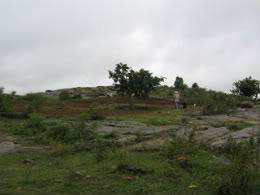 I wish I had a picture of the footprint to prove it, but as we had no camera on us, you will have to take my word for it. But here is a picture of our neighbour, Shankar, ploughing his fields with his oxen while his dog stands bossily by. On the western (left) slope of the hill, if you look closely, you may see the pride of our little community -- a dolmen.
I wish I had a picture of the footprint to prove it, but as we had no camera on us, you will have to take my word for it. But here is a picture of our neighbour, Shankar, ploughing his fields with his oxen while his dog stands bossily by. On the western (left) slope of the hill, if you look closely, you may see the pride of our little community -- a dolmen.
But I digress. The baby elephant. The immediate response was delight, the next, close on its heels, was terror. Where there's a baby elephant, can its mother be far behind or ahead? Not to mention sisters, cousins, aunts and grandmothers? We were, as I say, terrified, but we went bravely on, looking for more prints or other signs of pachyderm presence. I must confess here that our land has few trees and those that there are have been stunted by the previous owners' need for firewood. If there had been a heffalump to be seen, it would have seen us and we would have seen it at first glance. Anyway, as I say, we went bravely on and saw nothing more.
And so we had a happy, windy picnic and returned with the great satisfaction of having played host to a most majestic wild family without getting stomped on in the process.
 I wish I had a picture of the footprint to prove it, but as we had no camera on us, you will have to take my word for it. But here is a picture of our neighbour, Shankar, ploughing his fields with his oxen while his dog stands bossily by. On the western (left) slope of the hill, if you look closely, you may see the pride of our little community -- a dolmen.
I wish I had a picture of the footprint to prove it, but as we had no camera on us, you will have to take my word for it. But here is a picture of our neighbour, Shankar, ploughing his fields with his oxen while his dog stands bossily by. On the western (left) slope of the hill, if you look closely, you may see the pride of our little community -- a dolmen.
Published on September 12, 2011 09:30
August 26, 2011
The Tale of Topshe
'Hachiko: The Story of a Dog', a movie currently being aired on HBO, is just the kind of animal story I dislike. In a word, sad. Like Greyfriars Bobby, Hachiko lives the better part of his life devotedly (and futilely) awaiting the return of his dead master. I saw bits of the second half first and swore never to have anything to do with it. But then Srini saw the beginning and insisted I see it too. After much pleading and blackmailing I was dragged to the TV (well, where else can an old married couple whose kids have flown the nest eat dinner anyway?) and made to admire the pup Hachi. Of course I couldn’t hold out against its charms, any more than I could against the charms of our own Topshe. Which makes me think that every story of a dog adopted is a fairy tale with a happy ending.
Our old dog had died two years previously and, having sworn never to keep another, I decided to have my cake and eat it too by fostering pups for a stray-adoption agency. We were promptly delivered one number stray pup.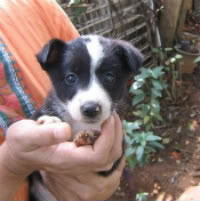 We were bowled over by the bright-eyed, badger-faced, fuzzy little bundle, but of course thought of it as ‘paraya dhan’ – the wealth of another family, as daughters were referred to in traditional Indian families. I was sure this was no stray. It looked like a border collie. Maybe it had wandered out of someone’s house. I searched the Internet for border collie owners in Bangalore, but there didn’t even seem to be one in all of the country. Still, there was an aura of mystery and romance about the pup. Like a royal changeling in a fairy tale, whose breeding shines through the grime and rags, it bore itself well. In its jaunty tux, snowy white shirtfront and socks, it was neat, friendly and confident. It was exciting to think this was a valuable champion going incog!
We were bowled over by the bright-eyed, badger-faced, fuzzy little bundle, but of course thought of it as ‘paraya dhan’ – the wealth of another family, as daughters were referred to in traditional Indian families. I was sure this was no stray. It looked like a border collie. Maybe it had wandered out of someone’s house. I searched the Internet for border collie owners in Bangalore, but there didn’t even seem to be one in all of the country. Still, there was an aura of mystery and romance about the pup. Like a royal changeling in a fairy tale, whose breeding shines through the grime and rags, it bore itself well. In its jaunty tux, snowy white shirtfront and socks, it was neat, friendly and confident. It was exciting to think this was a valuable champion going incog!
Then our wealth suddenly began to multiply in leaps and bounds, yips and squeaks.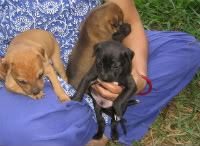 A lady called up to say four pups had been orphaned in a ditch outside her house, and could we foster them? We said yes, and went armed with a cardboard box to pick them up. If we had expected four more beauties, we were doomed to disappointment. After one look at them, our daughters christened them The Aliens, later to be softened to Harpo, Groucho, Chico and Zeppo. They were incredibly ugly, incredibly cute, and amazingly individualistic. Groucho, the biggest, was calm to the point of being bucolic, but would stand no nonsense from his siblings; Harpo was macho-but-clingy and had to be sung to sleep; Chico was the quiet one who lived to eat; and Zeppo -- the only girl -- was the friendly, spunky little runt.
A lady called up to say four pups had been orphaned in a ditch outside her house, and could we foster them? We said yes, and went armed with a cardboard box to pick them up. If we had expected four more beauties, we were doomed to disappointment. After one look at them, our daughters christened them The Aliens, later to be softened to Harpo, Groucho, Chico and Zeppo. They were incredibly ugly, incredibly cute, and amazingly individualistic. Groucho, the biggest, was calm to the point of being bucolic, but would stand no nonsense from his siblings; Harpo was macho-but-clingy and had to be sung to sleep; Chico was the quiet one who lived to eat; and Zeppo -- the only girl -- was the friendly, spunky little runt.
The Marx brothers were TINY, starved, crawling with poochies and infested with worms. Next to them the badger pup looked like an over-sized, over-privileged daughter of the aristocracy. It was intrigued by its new roommates, but oblivious to their heartrending yapping. It had a box of its own, while the Marx brothers slept in a large community box full of old clothes, piled up on each other for warmth, like tiny crocodiles. We kept the box covered with a thin sheet to keep in their warmth and the December cold out. It took the badger pup three days to discover where the others disappeared to; soon after, it learnt to yank the sheet off their box and set them yowling.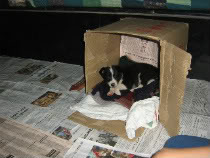
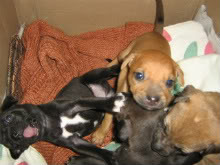 After a week of sleepless nights and days cleaning up puppy messes, we had almost had enough. Adoptive homes had been found for them and it was with great relief that we sent off four clean, healthy pups, just beginning to fill out, to their forever homes.
After a week of sleepless nights and days cleaning up puppy messes, we had almost had enough. Adoptive homes had been found for them and it was with great relief that we sent off four clean, healthy pups, just beginning to fill out, to their forever homes.
We were down to one pup of manageable size again. Now we focused our energies on finding it a home. The adoption agency seemed to have shot its bolt, so we forwarded photos to all and sundry, advertised on the Net and pestered friends. Meanwhile, our house had become the neighbourhood zoo – groups of kids dropped in at all hours of the day to visit the pup and play with it. Great fun, but very wearing!
A few weeks went by, and it seemed silly to keep calling it Puppy, so it acquired a name. After much debate and disagreement, it became Topshe, short for Tapesh Ranjan – after Feluda's young sidekick in Satyajit Ray’s detective stories. Actually, it only responded to ‘Mum-mum’ (food) and ‘Here, Oblivious’. It soon decided it had outgrown the cardboard box and began to colonize our beds. It also began to nip our ankles when we took it on walks. So besotted were we by this time that we decided that its behaviour harked back to its border collie ancestors with their herding instincts.
Meanwhile we kept receiving calls from strangers offering to give it a home. But this one sounded like he would abandon it when he went out of town, another said it would be kept tied in the yard all day – completely unacceptable, and that one actually wanted a cat, and could we find her one? And so on. The only suitable family (from Topshe's point of view) seemed to be ours…
And that was the end of my career as a pup fosterer and the beginning of Topshe’s life as an honest Srinivasan.
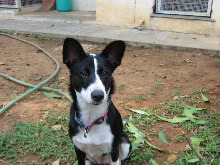
Our old dog had died two years previously and, having sworn never to keep another, I decided to have my cake and eat it too by fostering pups for a stray-adoption agency. We were promptly delivered one number stray pup.
 We were bowled over by the bright-eyed, badger-faced, fuzzy little bundle, but of course thought of it as ‘paraya dhan’ – the wealth of another family, as daughters were referred to in traditional Indian families. I was sure this was no stray. It looked like a border collie. Maybe it had wandered out of someone’s house. I searched the Internet for border collie owners in Bangalore, but there didn’t even seem to be one in all of the country. Still, there was an aura of mystery and romance about the pup. Like a royal changeling in a fairy tale, whose breeding shines through the grime and rags, it bore itself well. In its jaunty tux, snowy white shirtfront and socks, it was neat, friendly and confident. It was exciting to think this was a valuable champion going incog!
We were bowled over by the bright-eyed, badger-faced, fuzzy little bundle, but of course thought of it as ‘paraya dhan’ – the wealth of another family, as daughters were referred to in traditional Indian families. I was sure this was no stray. It looked like a border collie. Maybe it had wandered out of someone’s house. I searched the Internet for border collie owners in Bangalore, but there didn’t even seem to be one in all of the country. Still, there was an aura of mystery and romance about the pup. Like a royal changeling in a fairy tale, whose breeding shines through the grime and rags, it bore itself well. In its jaunty tux, snowy white shirtfront and socks, it was neat, friendly and confident. It was exciting to think this was a valuable champion going incog!Then our wealth suddenly began to multiply in leaps and bounds, yips and squeaks.
 A lady called up to say four pups had been orphaned in a ditch outside her house, and could we foster them? We said yes, and went armed with a cardboard box to pick them up. If we had expected four more beauties, we were doomed to disappointment. After one look at them, our daughters christened them The Aliens, later to be softened to Harpo, Groucho, Chico and Zeppo. They were incredibly ugly, incredibly cute, and amazingly individualistic. Groucho, the biggest, was calm to the point of being bucolic, but would stand no nonsense from his siblings; Harpo was macho-but-clingy and had to be sung to sleep; Chico was the quiet one who lived to eat; and Zeppo -- the only girl -- was the friendly, spunky little runt.
A lady called up to say four pups had been orphaned in a ditch outside her house, and could we foster them? We said yes, and went armed with a cardboard box to pick them up. If we had expected four more beauties, we were doomed to disappointment. After one look at them, our daughters christened them The Aliens, later to be softened to Harpo, Groucho, Chico and Zeppo. They were incredibly ugly, incredibly cute, and amazingly individualistic. Groucho, the biggest, was calm to the point of being bucolic, but would stand no nonsense from his siblings; Harpo was macho-but-clingy and had to be sung to sleep; Chico was the quiet one who lived to eat; and Zeppo -- the only girl -- was the friendly, spunky little runt.The Marx brothers were TINY, starved, crawling with poochies and infested with worms. Next to them the badger pup looked like an over-sized, over-privileged daughter of the aristocracy. It was intrigued by its new roommates, but oblivious to their heartrending yapping. It had a box of its own, while the Marx brothers slept in a large community box full of old clothes, piled up on each other for warmth, like tiny crocodiles. We kept the box covered with a thin sheet to keep in their warmth and the December cold out. It took the badger pup three days to discover where the others disappeared to; soon after, it learnt to yank the sheet off their box and set them yowling.

 After a week of sleepless nights and days cleaning up puppy messes, we had almost had enough. Adoptive homes had been found for them and it was with great relief that we sent off four clean, healthy pups, just beginning to fill out, to their forever homes.
After a week of sleepless nights and days cleaning up puppy messes, we had almost had enough. Adoptive homes had been found for them and it was with great relief that we sent off four clean, healthy pups, just beginning to fill out, to their forever homes. We were down to one pup of manageable size again. Now we focused our energies on finding it a home. The adoption agency seemed to have shot its bolt, so we forwarded photos to all and sundry, advertised on the Net and pestered friends. Meanwhile, our house had become the neighbourhood zoo – groups of kids dropped in at all hours of the day to visit the pup and play with it. Great fun, but very wearing!
A few weeks went by, and it seemed silly to keep calling it Puppy, so it acquired a name. After much debate and disagreement, it became Topshe, short for Tapesh Ranjan – after Feluda's young sidekick in Satyajit Ray’s detective stories. Actually, it only responded to ‘Mum-mum’ (food) and ‘Here, Oblivious’. It soon decided it had outgrown the cardboard box and began to colonize our beds. It also began to nip our ankles when we took it on walks. So besotted were we by this time that we decided that its behaviour harked back to its border collie ancestors with their herding instincts.
Meanwhile we kept receiving calls from strangers offering to give it a home. But this one sounded like he would abandon it when he went out of town, another said it would be kept tied in the yard all day – completely unacceptable, and that one actually wanted a cat, and could we find her one? And so on. The only suitable family (from Topshe's point of view) seemed to be ours…
And that was the end of my career as a pup fosterer and the beginning of Topshe’s life as an honest Srinivasan.

Published on August 26, 2011 01:44
July 31, 2011
Welcome, fellow earthlings!
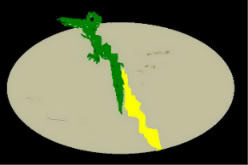
Ever since I can remember, I have tried to escape into a more beautiful, more exciting world. Books were one sure way of doing this, but so were animals, nature, travel, daydreaming... Fifty-odd years of living, bringing much grey hair and a little wisdom, have taught me that the real world is as wonderful and as exciting as the worlds of my imagination. People and places have stories, and even history and politics can be interesting. The life story of the guy next to you on the train, the struggles of your maid to bring up a family, the rabid convictions of your municipal corporator and the route taken by your city's sewage -- or not -- are potentially as thrilling as any book. It all depends on how you view it.
Unfortunately, I'm not all that much wiser. I'm still bent on escaping reality! My latest attempt has been to acquire some farmland close to a reserve forest. The prospect of being visited by wild elephants and leopards scares me silly, but also engenders many dreams and hopes of adventure.
In this blog, I hope to share these adventures as they unfold. I will also share the stories that I love, both the fantastic and the real; the animals, people, books, places, pictures and music that have brought me delight, touched me or made me laugh. I hope you enjoy them too!
Published on July 31, 2011 04:20
Read, Write and Left
Blog of a somewhat indiscriminate reader and gauche (in the French sense of course) writer.
- Harini Gopalswami Srinivasan's profile
- 71 followers


